MP Board Class 7th Science Solutions Chapter 5 Acids, Bases and Salts
Acids, Bases and Salts Intext Questions
Question 1.
Can I taste all substances to find their taste?
Answer:
No, we should not taste unknown substances. They could harm us.
Question 2.
I am not getting the same result when using solid baking soda on dry litmus paper. Why?
Answer:
Make a solution of baking soda and then try.
![]()
Activities
Activity 1
Let us recall tastes of some edible substances listed in table. If you have not tasted any of these substances taste it now and enter the result in the given table.
Answer:
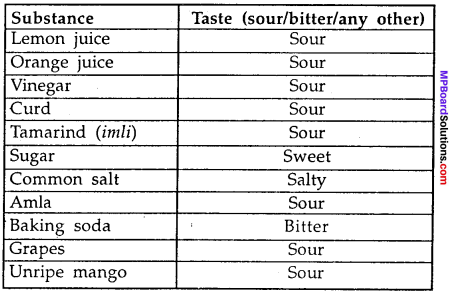
Activity 2
Mix some water with lemon juice in a plastic cup/ tumbler/ test tube. Put a drop of the above solution on a strip of the red litmus paper with the help of a dropper.
- Is there any change in colour.
- Repeat the same exercise with the blue litmus paper.
- Note down if there is any change in colour.
Perform the same activity with the following substances:
Tap water, detergent solution, aerated drink, soap solution, shampoo, common salt solution, sugar solution, vinegar, baking soda solution, milk of magnesia, washing soda solution, lime water. If possible make solutions in distilled water. Record your observations as in table.
Answer:
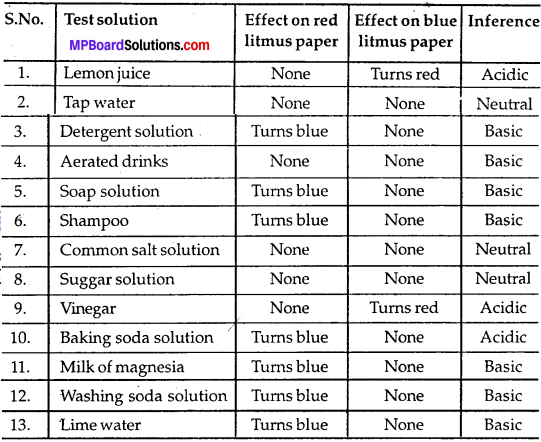
Activity 3
Take a tablespoonful of turmeric powder. Add a little water and make a paste.
Make turmeric paper by depositing turmeric paste on blotting paper/filter paper and drying it. Cut thin strips of the yellow paper obtained.
- Put a drop of soap solution on the strip of turmeric paper.
- What do you observe
- Similarly test the solutions listed in table and note down your observations.
Answer:
The turmeric turns red.
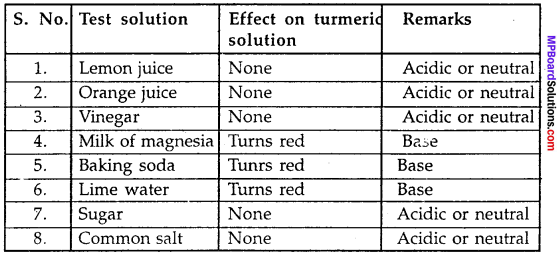
Acitivity 4
Collect some China rose (Gudhal) petals and place them in a beaker. Add some warm water. Keep the mixture for some time till water becomes coloured. Use the coloured water as an indicator. Add five drops of the indicator to each of the solutions given in table:
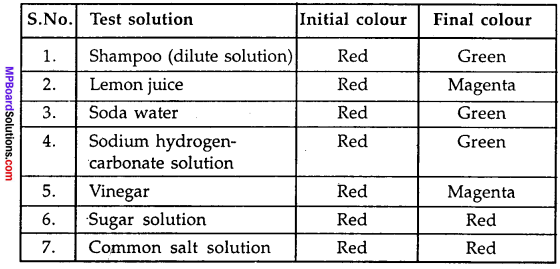
Acids, Bases and Salts Text book Exercises
Question 1.
State ditterences between acids and bases?
Answer:
Differences between acids and bases:
Acids:
- Acids are substances which contain one or more replaceable hydrogen atoms.
- All acids are sour in taste.
- All acids turn blue litmus red.
- Acids are compounds that contain hydrogen.
- Acids react with metal to form salts and release hydrogen gas.
Bases:
- Bases are substances which have one or more replaceable hydroxyl group (OH).
- Bases are bitter in taste and slippry in touch.
- Bases turn red litmus blue.
- Bases are compound which have hydroxyl group.
- Bases react with acids to form salts.
![]()
Question 2.
Ammonia is found in many household products, such as window cleaners. It turns red litmus blue. What is its nature?
Answer:
Basic.
Question 3.
Name the source from which litmus solution is obtained. What is the use of this solution?
Answer:
Litmus solution is extracted from lichens. It is used as indicator.
Question 4.
Is the distilled water acidic/basic/neutral? How would you verify it?
Answer:
The distilled water is neutral.
Put a drop of distilled water on a strip of the red litmus paper with the help of a droper. We observe that colour of the litmus paper is not change. The solutions which do not change the colour of either red or blue litmus are knwon as neutral solutions. These substances are neither acidic nor basic.
![]()
Question 5.
Describe the process of neutralisation with the help of an example?
Answer:
The reaction between an acid and a base is known as neutralisation. Salt and water are produced in this process with the evolution of heat.
Acid + Base → Salt + Water
Example: Following reaction:
Hydrochloric acid (HCl) + Sodium hydroxide (NaOH) → Sodium chloride (NaCl) + Water (H2O)
Question 6.
Mark ‘T’ if the statement is true and ‘F’ if it is false:
- Nitric acid turn red litmus blue. (T/F)
- Sodium hydroxide turns blue litmus red. (T/F)
- Sodium hydroxide and hydrochloric acid neutralise each other and form salt and water. (T/F)
- Indicator is a substance which shows different colours in acidic and basic solutions. (T/F)
- Tooth decay is caused by the presence of a base. (T/F)
Answer:
- False (F)
- False (F)
- True (T)
- True (T)
- False (F).
Question 7.
Dorji has a few bottles of soft drink in his restaurant. But, unfortunately, these are not labelled. He has to serve tire drinks on the demand of customers. One customer wants acidic drind, another wants basic and third one wants neutral drink. How will Dorji decide which drink is to be served to whom?
Answer:
- He can decide by the use of indicator.
- It the sample of drink turns red litmus blue, it is basic. It it turns blue litmus red, it is acidic.
- It it does not effect litmus, then it is neutral.
![]()
Question 8.
Explain why?
- An antacid tablet is taken when you suffer from acidity.
- Calamine solution is applied on the skin when an ant bites.
- Factory waste is neutralised before disposing it into the water bodies.
Answer:
1. Our stomach contains hydrachloric acid. It help us to digest food. But too mcuh of acid in the stomach causes indigestion. Sometimes indigestion is painful. To relieve indigestion, we take an antacid such as milk of magnesia, which contains magnesium hydroxide. It neutralises the effect of excessive acid.
2. Ant injects an acid (i.e., formic acid) during bite which cavses the burning sensation. Calamine solution is basic in nature. It neutralises the acid and relives us from the pain.
3. Factory wastes contain both acidic and basic substances. If they are allowed to flaw into the water bodies, they are harmful for orgainsms living in water. So the factory wastes are neutralised by adding basic substances.
Question 9.
Three liquids are given to you. One is hydrochloric acid, another is sodium hydroxide and third is a sugar solution. How will you identify them? You have only turmeric indicator.
Answer:
Turmeric solution turns red in contact with bases. It is not affected by acids and neutral substances. So, first we will identify the base.
Now, the base is taken and turmeric is added. It will turn red. Then, one of the solutions is added to it gradually. If the solution turns yellow again, the added liquid is hydrochloric acid because it neutralises the base. Otherwise the added liquid is sugar solution.
![]()
Question 10.
Blue litmus paper is dipped in a solution. It remains blue. What is the nature of the solution? Explain.
Answer:
The nature of the solution is neutral, because the solutions which do not change the colour of either red or blue litmus are known as neutral solution. These substances are neither acidic nor basic.
Question 11.
Consider the following statements:
- Both acids and bases changes colour of all indicators.
- If an indicator gives a colour change with an acid, it does give a change with a base.
- If an indicator changes colour with a base, it does not change colour with an acid.
- Change of colour in an acid and a base depends on the type of the indicator.
Which of these statements are correct?
- All four
- (a) and (d)
- (b) and (c)
- only (d)
Answer:
4. only (d).
Extended Learning – Activities and Projects:
Question 1.
Using the knowledge of acids and bases, write a secret message with the help of baking soda and beet root. Explain how it works?
Answer:
Prepare baking soda solution in water. Use this solution to write the message on a sheet of white paper with a cotton bud. Rub a slice of fresh beet root over the message.
![]()
Question 2.
Prepare red cabbage juice by boiling a piece of red cabbage in water. Use it as an indicator and test the acidic and basic solutions with it. Present your observations in the form of a table?
Answer:
Do with the help of your subject teacher.
Question 3.
Bring the soil sample of your area, find out if it is acidic, basic or neutral. Discuss with farmers if they treat the soil in any manner?
Answer:
Do yourself.
Question 4.
Visit a doctor. Find out the medicines, he prescribes to treat acidity Ask him how acidity can be prevented?
Answer:
Do yourself.
Acids, Bases and Salts Additional Important Questions
Objective Type Questions
Question 1
Choose the correct alternative
Question (i)
Bases are –
(a) Sour in taste
(b) Sweet in taste
(c) Bitter in taste
(d) None of the above.
Answer:
(c) Bitter in taste
Question (ii)
Blue litmus turns red by –
(a) Sodium
(b) Sodiujn sulphate
(c) Bitter in taste
(d) Qattstic potash.
Answer:
(c) Bitter in taste
![]()
Question (iii)
Which one of the following oxides will react with acids to salt and water –
(a) CO
(b) SO2
(c) SO3
(d) CuO.
Answer:
(d) CuO.
Question (iv)
Which of the following is a mineral acid –
(a) Acetic acid
(b) Citric acid
(c) Tartaric acid
(d) Nitric acid.
Answer:
(d) Nitric acid.
Question (v)
Which is the common name of sodium bicarbonate –
(a) Caustic soda
(b) Washing soda
(c) Blue vitriol
(d) Baking soda.
Answer:
(d) Baking soda.
Question (vi)
For diluting acid –
(a) Water is added to acid.
(b) Acid is added to water.
(c) Acid is boiled after adding water.
(d) Acid is boiled before adding water.
Answer:
(c) Acid is boiled after adding water.
Question (vii)
……………. is used for white – washing in house.
(a) Sodium hydroxide
(b) lime stone, calcium hydroxide
(c) blue vitriol
(d) lime water and ash.
Answer:
(b) lime stone, calcium hydroxide
Question (viii)
Nausadar is –
(a) Acid
(b) Alkali
(c) Salt
(d) Indicatior
Answer:
(c) Salt
Fill in the blanks:
- Acetic acid is present in while is present ………….. While …………. is present in lemon.
- Magnesium burns in air to form …………. which is ………….. oxide.
- The chemical formula of slaked lime is ……………..
- Acids are …………….. in taste.
- The gas which escapes out from many aerated soft drinks is …………..
- ………….. are slippery in touch.
- Bases turn ………….. litmus to …………..
- In a neutralisation reaction an ………….. and an ………….. combine to form a salt and water.
- The solution formed by reacting P2 O5 with H2O turns ………….. litmus ……………
- Methyl orange is a good ……………
Answer:
- Vinegar, citric acid
- Magnesium oxide, basic
- Ca2, (OH)2
- Sour
- CO2
- Bases
- Red, blue
- Acid, alkali
- Blue, red
- Indicator.
![]()
Question 3.
Which of the following statements are true (T) or false (F):
- Acids have a bitter taste.
- Bases have a bitter taste.
- Bases react with carbonate to liberate carbon dioxide.
- Copper does not reach with tamarind (imli) water.
- Sulphuric acid is c.’led ‘King of chemicals’.
- Orange juice turns blue litmus red.
- Alum (Phitkari) acts as a antacid.
- Soaps are salts of fatty acids.
- Copper sulphate is used as a preservative in pickels. Potassium chloride is a salt of sulphuric acid.
Answer:
- False
- True
- False
- True
- True
- True
- False
- True
- False
- False.
Question 4.
Paheli brought the following paheli (riddle) for you.
- Coffee is brown
- And bitter in taste
- Is it an acid
- Or a base
- Don’t give the answer
- Without any test
- You are in the dark With its taste
Answer:
Acidic.
Acids, Bases and Salts Very Short Answer Type Questions
Question 1.
Which acid is present in our stomach?
Answer:
Hydrochloric acid in small amount is present in our stomach.
Question 2.
What will you do if some acid is split on the table?
Answer:
We will sprinkle some base on the table to neutralise the effect of the acid.
Question 3.
Why antacids tablests are used to reduce acidity of the stomach?
Answer:
Sometimes due to spicy food the concentration of hydrochloric acid increases in the stomach. This causes acidity. To reduce it some harmless bases are used like milk of magnesia [Mg (OH)2] and aluminium hydroxide, which balance the excess of acids. These are solid in the form of tablets called antacids.
![]()
Question 4.
What are mineral acids? Give two examples.
Answer:
The acids which are capable of forming hydrogen ions, when dissolved in water are mineral acids. For example, HCl, HNO3, H2SO4 (Hydrochloric acid, Nitric acid, Sulphuric acid). In other words, mineral acids are strong acids. These acids are called mineral acids because these are prepared from minerals.
Question 5.
What are organic acids? Give two Examples.
Answer:
Organic acid are soured milk, lemon, green mangoes and karvanda are sour tasting. All of them contain some naturally occurring acids. Such acids are found in animals and plant materials. They are known as organic acids.
Examples: Lactic acid, Citric acid, Vinegar, Formic acid.
Question 6.
What do you understand by concentrated and dilute acids?
Answer:
Concentrated acid:
The acids which are prepared by dissolving in water, are known as concentrated acid.
Dilute acid:
The acid which are prepared by dissolving in excess amount of water are known as dilute acids.
Question 7.
Name the gas obtained when a metal carbonate reacts with an acid?
Answer:
When metal carbonate reacts with acids they give carbon dioxide gas.
Question 8.
What will happen if blue litmus paper is soaked in orange juice?
Answer:
It change into red colour.
Question 9.
State one characteristic property of all acids. Is dry hydrogen chloride gas an acid?
Answer:
- Acids have a sour taste.
- Acids turn blue litmus red.
- Acids react with metal to evolve hydrogen gas.
2HCl + Mg → MgCl2 + H2
Yes, hydrogen chloride is an acid.
Question 10.
A solution turns red litmus paper into blue. What does this indicate about the chemical nature of the solution?
Answer:
The solution which turns red litmus paper blue is basic in nature. The substance which turns red litmus paper blue is known as alkalies.
![]()
Question 11.
Classify the following chemicals in acids and bases:
KON, HNO3, Ca(OH)2, LiOH, CH3COOH, HCOOH, Mg(OH)2, NaOH, H2SO4, HCl
Answer:
Acids:
HNO3, H2SO4, HCl.
Bases:
KOH, Ca(OH)2, LiOH, CH3COOH, HCOOH, Mg(OH)2, NaOH.
Acids, Bases and Salts Short Answer Type Questions
Question 1.
You are given hydrochloric acid solution, sodium hydroxide solution and water in three different bottles. How will you check which bottle has which compound?
Answer:
Take three pieces of blue litmus paper. Put one piece of blue litmus paper into each of these solutions. That bottle which turns blue litmus red contains hydrochloric acid. Take three pieces of red litmus paper. Put one piece of red litmus paper into each of these solutions. That bottle which turns red litmus blue contains sodium hydroxide (base).
Question 2.
How can you test the presence of acid in a substance?
Answer:
Acids can be tested in any substance by the following methods:
- Take a drop of the dilute solution of the substance on the tips of your tongue. If it taste sour, it is acid.
- Place a blue litmus paper in the solution. If the colour changes to red, acid is present.
Example: 2Na + 2HCl → 2NaCl + H2
![]()
Question 3.
What are indicators? Name two acid – base indicators.
Answer:
The substance which are used to identify whether a substance is an acid or base is called indicators. For example, litmus solutions give red colour with acids and blue colour with bases. Therefore, litmus is used as indicator. Substances wrhich given differnet colours with acid and base are called acid – base indicators.
Example:
- Methyl orange
- Phenolpthalein
Question 4.
State the colour of dry litmus paper when placed in separate samples of dilute sulphuric acid, moist ammonia gas, moist chlorine, sodium hydroxide, lemon juice, vinegar and water into which sulphur dioxide gas has been bubbled for some time?
Answer:
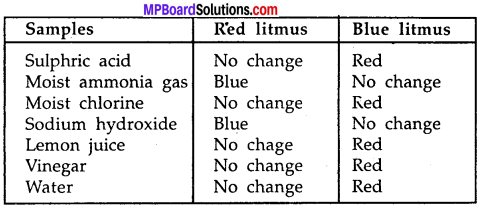
Question 5.
Why are acids not stored in metal containers? Containers/ vessels made from which material are safe to store acids?
Answer:
All the acids react with metals. They react vigorously and slowly with metals according to their nature. So, the acids are not stored in metal containers. Vessels made from glass or cermics are considered safe for strong acids.
Question 6.
Which acids are present in following substance:

Answer:
- Citric acid
- Acetic acid
- Lactic acid
- Oxalic acid
- Tartaric acid.
Question 7.
Why does colour of blue vitriol change when heated?
Answer:
When we blue vitriol heated it changes into white vitriol and water.

Question 8.
Write one use of each of the following compounds?
- Vinegar
- Methly orange
- Alum
- Sulphuric, acid
- Sodium hydroxide.
Answer:
- In pickles and jam for preserving it in good condition for long duration.
- As a indicator.
- In purifying water.
- In purifying pertroliujn products.
- In purifying pertrolium products.
![]()
Question 9.
What are acid salts? Give two examples?
Answer:
Acid salt:
When a strong acid is neutralised by a weak base, then a salt is formed, such type of salt is called acid salt.
For example:
H2SO4 + 2NH4OH → (NH ) SO4 + 2H2O
HCl+ NH4OH → NH4Cl + H2O
Question 10.
Complete the following equations:
- NaOH + H2SO4 → ……………. + H2O
- H2CO3 + NaOH → ……………. + H2O
- HNO3 + KOH → ……………. + H2O
- Mg (OH)2 + 2HCl → ……………. + 2H2O
Answer:
- NaOH + H2SO4 → Na2SO4 + H2O
- H2CO3 + 2NaOH → Na2CO3 + 2H2O
- HNO3 + KOH → KNO3+ H2O
- Mg (OH)2 + 2HCl → + MgCl2 + 2H2O
Question 11.
Name the gas obtaines when a metal carbonate reacts with an acid?
Answer:
When metal carbonate reacts with acids they give carbon dioxide gas.
For example.

Question 12.
Differentiate between bases and alkalies by giving suitable examples of each?
Answer:
Bases:
Bases are the compound which have one or more hydroxyl group (OH) in their molecule.
Examples: NaOH, Ca(OH)2, KOH etc.
Alkalies:
Water soluble bases are called alkalies.
Examples: Sodium hydroxide, potassium hydroxide and calcium hydroxide.
Question 13.
What is a neutralisation reaction? Give two examples.
Answer:
The reaction of an acid with an alkali and vice – versa to form salt and water is called neutralisation reaction.
For examples:

![]()
Question 14.
How is salt obtained from sea – water?
Answer:
The seas are great sources of salts. A litre of a water contains about 35 grams of salts. Sodium chloride is the main salt. The sea water is trapped in shallow called lagoons and is allowed to evaporate in sunlight to white solid crystal of salts. These crystals are processed and packed to send to markets.
![]()
Question 15.
What are the uses of weak alkalies?
Answer:
- Ammonia is a weak alkali. It is used for the manufacture of fertilizers.
- Ammonia is also used for the production of wood pulp and organic chemicals.
- It is also used for making synthetic fibres such as nylon and nitric acid, which are used for the preparation of synthetic cloth.
- Calcium hydroxide is used in the manufacture of bleaching powder.
Question 16.
Tabulate the some hydrated salts with their chemical formulae and colour?
Answer:
Some hydrated salts:

Question 17.
Name some common acid and alkali indicators?
Answer:

Acids, Bases and Salts Long Answer Type Question
Question 1.
What are acids? Write their properties.
Answer:
Acids are substances which contain one or more replaceable hydrogen atoms. Its properties are:
-
- All acids are sour in taste.
- All acids turn blue litmus red.
- Acids are compounds that contain hydrogen e.g., H2SO4, HCl etc.
- Acids are compounds which form hydronium ion (H3O+) in aqueous (water) solution.
Example:

- Acids react with metal to form salts and release hydrogen gas.
Example: 2Na + 2 HC1 → 2NaCl + H2
- Acids react with carbonates and bicarbonates to give carbon dioxide gas.
Example:

Question 2.
What are bases? Write down its properties.
Answer:
Bases are substances which have one or more replaceable hydroxyl group (OH).
The various properties of bases are:
- Bases are bitter in taste and slippery in touch.
- Bases turn red litmus blue.
- Bases are compound which have hydroxyl group.
- All bases give hydroxyl ion into aqueous solutions.

- Bases react with acids to form salts.
Example: NaOH + HCl → NaCl + H2O
Question 3.
What are the uses of mineral acids in industry?
Answer:
The uses of mineral acids in industry are:
1. Concentrated sulphuric acid, nitric acid and hydrochloric acid are used in a large number of metallurgical operations, manufacture of fertilizers and preparations of large number of industrial chemicals.
2. Hydrochloric acid is used for removing the deposits from inside the boilers. This process is known as descaling.
3. One of the mineral acid, hydrochloric acid (HCl) present in our stomach helps in digestion of food.
4. Nitric acid (HNO3) is used by goldsmiths for cleaning gold and silver ornaments.
![]()
Question 4.
Distinguish clearly between the following terms by giving suitable examples:
- Organic acid and mineral acid.
- Base and alkali.
Answer:
1. Organic acid:
- Organic acid contains COOH functional group.
- These acids are weak.
- These acids are present in humans and plants.
- They are less corrosive and are used in food ingradients.
Examples: Ethanoic acid, lactic acid, citric acid.
Mineral acid:
- Mineral acid contains hydrogen ions (H+).
- These acids are strong.
- These acids are prepared by mankind.
- They are corrosive in nature and have industrial use.
Examples: Hydrochloric acid, sulphuric acid, nitric acid.
2. Base:
- Bases are the compound which have one or more hydroxhyl group (OH) in their molecule.
- All alkalies are bases
- Bases are insoluble in water.
Examples: NaOH, Ca(OH)2, KOH
Alkali:
- Water soluble bases are called alkalies.
- All bases are not alkalies.
- Alkalies are soluble in water.
Examples: Sodium hydroxide potassium hydroxide and calcium hydroxide.
![]()
Question 5.
Write any three most common salts used in daily life and write their uses?
Answer:
Most common salts used in daily life are:
1. Washing Soda: Na2CO3.10H2O.
Uses:
- It is used in laundary.
- It is used to prepare other compounds such as glass, caustic soda and detergent poweders.
2. Baking Soda: NaHCO3
Uses:
- It is used in baking powder.
- It is used as medicine to reduce acidity of the stomach.
- It is used in fire extinguisher.
3. Potash alum or phitkari:
K2SO4.Al2(SO4)324H2O
Uses:
- It is used to purify water.
- It is used after shave to stop the bleeding from cuts.